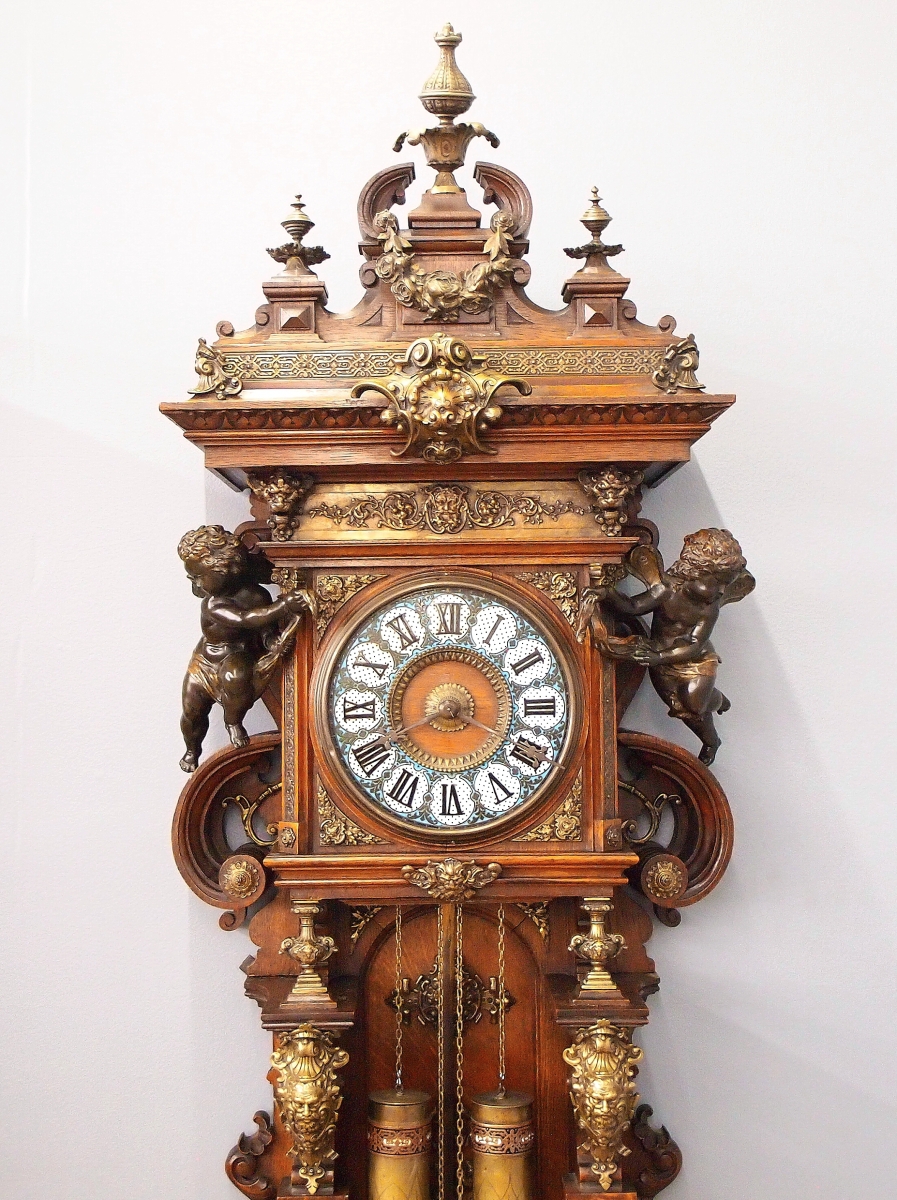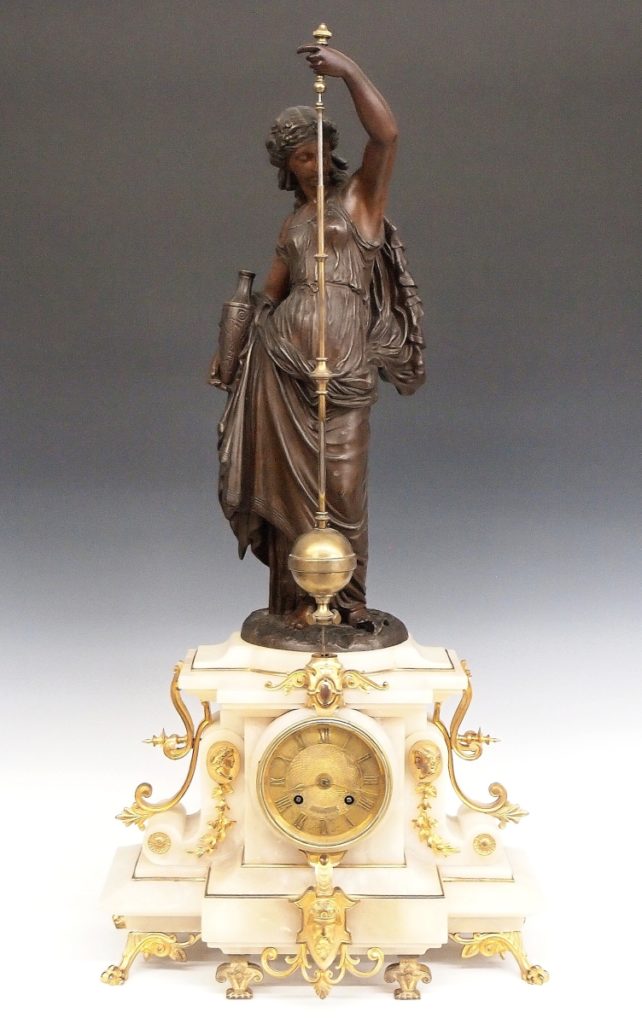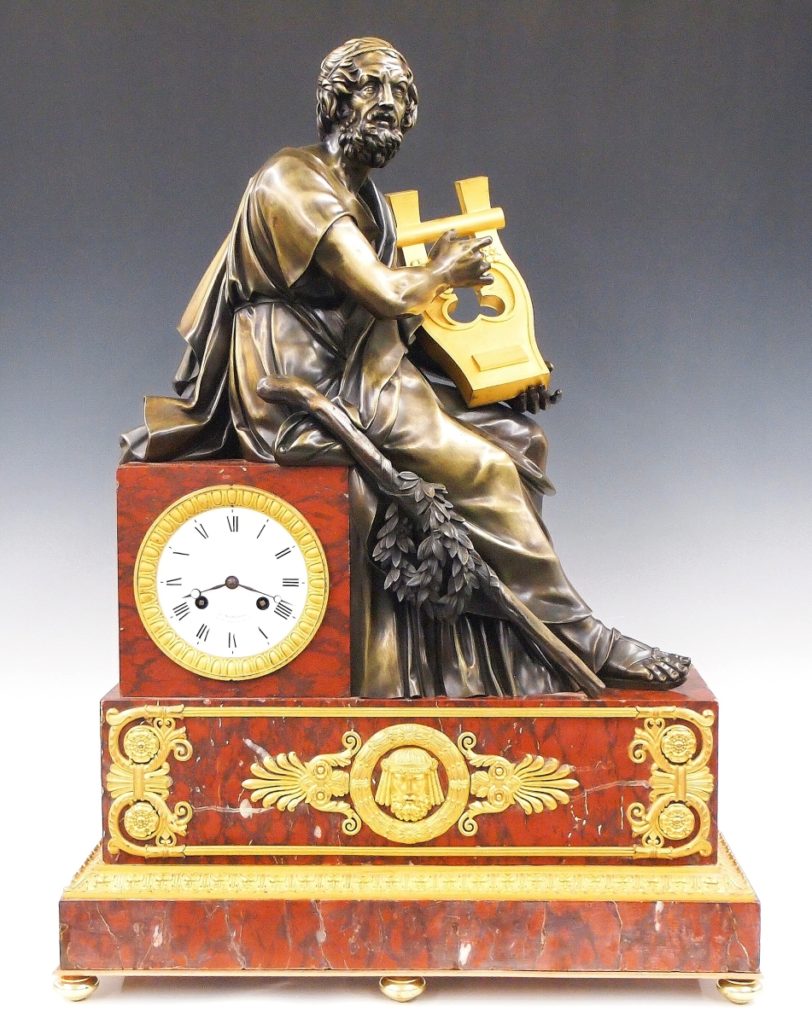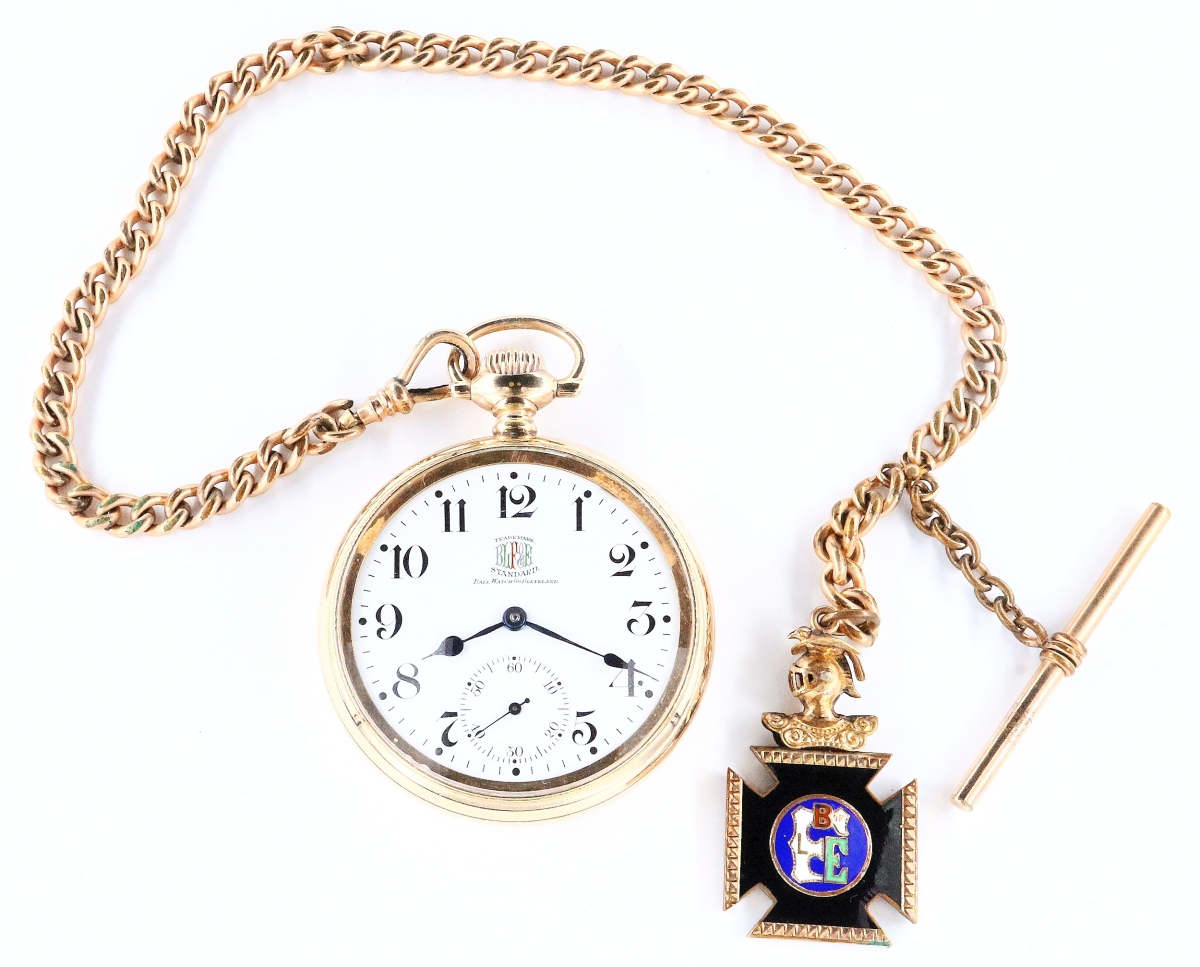
Described as “a good Nineteenth Century German hall clock,” this classic weight-driven example struck a resounding $22,500 after 23 bids to grace a new hall. It was the highest price realized in the sale ($8/12,000).
Review by Marty Steiner, Photos Courtesy Schmidt’s Antiques
YPSILANTI, MICH. – Remember when telling time included the little hand and the big hand? Those times were back at Schmidt’s Antiques Clocks and Watches auction on October 1. Only a couple of digital clocks were even offered, and it wasn’t an electronic display. Catalog descriptions were detailed with even minor faults identified. Every clock and watch listed had been tested and their status as running or needing even minor adjustment at cataloging time was included in the description.
Advance interest in this sale was evidenced by the number of lots with advanced bids. Among these were 11 lots that would eventually be among the top 20 lots of the sale.
Tall clocks, as a group, had the highest catalog estimates and would be expected to top this sale. In the top spot with a $22,500 price, clearing its $8/12,000 estimate, was an attributed LFS (Lorenz Furtwangler & Sohne) eight-day weight-driven German hall clock. Housed in an oak case, it was embellished with a number of decorative bronze mounts and cherubs. Following closely, in third position overall, was a turn-of-the-century Walter Durfee eight-day weight-driven grandfather clock with quarter-hour, eight-bell “chimes.” It was housed in a mahogany Chippendale case with hand-carved features. This grandfather brought $10,625 ($4/6,000). Two additional tall/grandfather clocks rounded out the top ten lots.
Figural clocks, with human or animal forms as their name implies, may include just a single figure or an entire scene with the figure just an element. A draped damsel, the Greek muse Urania, stood holding the top of a pendulum that motivated a Eugene Farcot clock mounted in a black slate base with gilded decoration at her feet. She drew $16,250 ($8/12,000). This took her to second place in the dollar rankings. This example was one that also offered an online video of it running when cataloged. Not far behind was another Farcot example with Greek Danaides suspending the pendulum above a white alabaster case for $10,000 ($3/4,000). She drew sixth in overall placing.

A Eugene Farcot example with Greek Danaides suspending a pendulum above a white alabaster case went out at $10,000 ($3/4,000).
German Black Forest clocks drew much attention and strong bidding. Telling much more than time, a Nineteenth Century table clock was housed in a carved walnut case with a vivid scene of a hawk attacking a rooster, hen and their chicks. The successful bidder attacked the $6/8,000 estimate with a $10,625 win. This placed fourth overall in this sale.
An innovative turn-of-the-Nineteenth Century Black Forest wall clock announces the hour with a five-horn melody as a small horn player emerges. The melody that announced this result was $8,125 ($4/6,000). All together, ten Black Forest clocks were sold in this sale. Another walnut-cased Black Forest table clock featured a hunter seated on the clock with his dog flanking the dial. This clock announced the hours with its multi-tune music box. That winning tune was $6,250 ($4/6,000).
Bracket clocks are so named because of their original design and purpose. Among the earliest clock designs, they were designed to be portable. Frequently mounted on top with handles to facilitate movement, they would attach to wall-mounted brackets. The highest priced bracket clock in this sale was a Gothic Revival eight-bell bracket clock at $6,875, besting its $4/6,000 estimate. This example came with its original bracket. It featured eight bell chimes on the quarter hour and a gong on the hour. Eight additional bracket clocks sold from $250 to $2,125. Although not running, the runner-up French boulle bracket clock included some unusual features, including a moon phase globe and two subsidiary dials that indicated the date/month/zodiac sign and day of the week/moon phase.
Bracket clocks evolved into table, shelf and mantel clocks. Table clocks, mantel clocks and shelf clocks can be rather arbitrary descriptions because many of these clocks would be usable on shelves, tables or mantels. This article has relied on the catalog description to identify a specific clock.

The French Empire bronze and marble eight-day time-and-strike mantel clock by Honore Pons, marked by the original retailer, B. Marchand Richelieu, brought $3,750. A seated bronze figure of Homer with a lyre topped the clock, which was housed in a rouge marble case ($2/3,000)
As it became fashionable for fireplaces to have shelves, clocks found their way to that central location of most fireplaces. The 24 mantel clocks offered were led at $3,750 by a French Empire period rouge/red marble base and clock case topped with a bronze seated Homer playing a lyre. A somewhat entertaining Eugene Farcut French example had a cherub on a swing suspended below the clock. The winner of this clock on an upswing paid $1,875 against the $400/600 estimate. The mantel clock with the highest catalog estimate, $3/4,000, was a French Louis XV-style marble base with a mother and sleeping child figures on top. It failed to reach its estimate of $3/4,000, selling for only $1,875.
Among the 38 shelf clocks were some interesting examples. A late Nineteenth Century Ithaca Clock Co. “Favorite” calendar clock featured a Roman numeral face at the top and a lower face with calendar dial and two apertures, one showing the month and the other the day of the week. All this for $1,875, far more than the $400/600 estimate. Another similar Ithaca calendar example, running, but in need of restoration, fetched only $438 ($200/300).
Two mystery clocks were sold in this sale. Mystery clocks (and, yes, there are mystery watches) are clocks that appear to have no connection between the hands and the mechanism. Both of the mystery clocks in this sale were French Nineteenth Century examples. A bronze Greek goddess stands on a black slate base with her upraised hand holding the top of a pendulum. The raised hand of the successful bidder ended the lot at $8,125 ($6/8,000). Noted as not running, the other mystery clock, with draped female also suspending a pendulum, found a buyer at only $1,500 ($600/800).
Watches accounted for 48 lots with half having some railroad affiliation. Two lots of ladies’ watches included an E. Raffin, Geneva, 14K example with an enamel scene of two ladies in a garden. The ladies left for $469 ($400/600). A group of four gold-filled ladies’ pendant watches, Elgin and Waltham, brought $406 ($300/400). One interesting watch example was an Elgin 1893 World’s Columbian Exposition Chicago watch with two attached souvenir fobs. Where were the World’s Fair Collectors that missed this for $200, barely making the $200/400 estimate?

Many of the few pocket watches in this sale were railroad related. These watches kept the trains on schedule. The most representative of these, with both watch face and chain fob exhibiting the B. of L.F.&E. (Brotherhood of Locomotive Firemen and Enginemen) logo, was sold right on schedule for $2,625 ($2/3,000).
As in any collecting specialty, information is valuable. Among the resources available to the clock and watch collector is the National Association of Watch & Clock Collectors (NAWCC). Located in Columbia, Penn., the group operates a museum, library and research center. The association offers a variety of membership levels with an associate membership as low as $30 per year, which includes various association publications. The website is www.nawcc.org. Another similar resource is the Black Forest Clock Collectors website and forum (www.blackforestclockcollectors.com). This site presents restoration projects, resources, shows and the like for this portion of the clock collecting community.
Information that may be helpful also can be obtained from Sasvage & Polite’s Antique Clocks Identification & Price Guide (www.antiqueclockspriceguide.com). Www.ClocksInfo.com also offers much information with dating and identifying information. A variety of specialized sites are also maintained by various dealers and other sources.
The initial results of this sale were revised shortly after closing when a significant bidder was unable to complete the purchase. Some high-dollar lots were affected. Schmidt’s Antiques offers a wide variety of auctions in addition to its clocks and watches sale; future sales include one on November 19 and the firm’s annual New Year’s Day auction on January 1.
Prices given include the buyer’s premium as stated by the auction house. For information, www.schmidtsantiques.com or 734-434-2660.




















